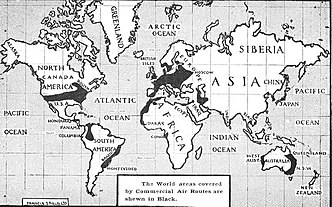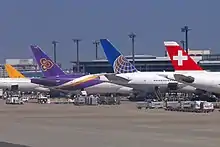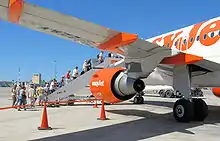Commercial aviation
Commercial aviation is the part of civil aviation (both general aviation and scheduled airline services) that involves operating aircraft for hire to transport passengers or multiple loads of cargo.

History
Origins

Harry Bruno and Juan Trippe were early promoters of commercial aviation.
The Air Commerce Act of 1926 began to regularize commercial aviation by establishing standards, facilitation, and promotion. An Aeronautical Branch was established in the Department of Commerce with William P. MacCracken, Jr. as director. To promote commercial aviation, he told town fathers that "Communities without airports would be communities without airmail."
Writing for Collier's in 1929, he noted "Commercial aviation is the first industry inspired by hero-worship and built upon heros". He cited the promotion in South America by Herbert Dargue in early 1927. After his trans-Atlantic flight, Charles Lindbergh made a tour of the 48 States paid for by the Guggenheim Foundation for the Promotion of Aeronautics. From that point commercial aviation took off:
Roads were chocked on Sundays for weeks afterward, by motorists trying to get to Lambert Field, Lindbergh's home port in Saint Louis, to buy their first air hop. Hundreds of thousands of you went aloft for the first time that summer.[1]

The Aeronautical Branch was charged with issuing commercial pilot licenses, airworthiness certificates, and with investigating air accidents.[2]
Post-war aviation
After World War II, commercial aviation grew rapidly, using mostly ex-military aircraft to transport people and cargo. The experience used in designing heavy bombers such as the B-29 and Avro Lancaster could be used for designing heavy commercial aircraft. The DC-3 also made for easier and longer commercial flights. The first commercial jet airliner to fly was the British de Havilland Comet. By 1952, the British state airline BOAC had introduced the Comet into scheduled service. While a technical achievement, the plane suffered a series of highly public failures, as the shape of the windows led to cracks due to metal fatigue. The fatigue was caused by cycles of pressurization and depressurization of the cabin, and eventually led to catastrophic failure of the plane's fuselage. By the time the problems were overcome, other jet airliner designs had already taken to the skies.
Latin America
Until 1950s
Inspired by the major players such as the United States, the Soviet Union, Russia, France and Britain in the aviation industry. In 1910s, Brazil and Argentina were one of the first Latin American countries to possess the instruments of aircraft that were not all locally made, yet the aircraft was locally congregated.[3] At that time, many individuals were interested to be pilots in Latin American countries, yet there were not sufficient resources and funding to support and promote the best interests of the aviation industry. [3] Amidst these obstacles, Argentina and Dominican Republic made efforts in creating jet aviation rather than creating and using propeller planes.[4] In 1944, the Chicago Convention on International Civil Aviation attended by all Latin American countries except Argentina drafted the clauses of aviation law.[5] The introduction of the jet fighter F-80 by the U.S. in 1945 pushed the Latin American countries even further away from development of aviation industry because it was simply expensive to recreate the sophisticated technology of F-80. [3]
1970s
The Latin American Civil Aviation Commission (LACAC) was formed in December 1973 "intended to provide civil aviation authorities in the region with an adequate framework for cooperation and coordination of activities related to civil aviation".[6] In 1976, about seven percent of the world logged in the Latin American and Caribbean region.[5] This contributed to the increase of average annual rate of air traffic.[5] Subsequently, higher passenger load factor decided the profitability of these airlines.
According to C. Bogolasky, Airline pooling agreements between Latin American airlines contributed to better financial performance of the airlines. The economic problems related to the "airline capacity regulation, regulation of non-scheduled operations, tariff enforcement, high operating costs, passenger and cargo rates."[5]
Corporate Social Responsibility
Corporate Social responsibility (CSR) comprises an umbrella of responsibilities of an organization towards its community, stakeholders and shareholders.[7] Organizations who are socially responsible fulfill their Triple Bottom Line obligations and dedicate efforts to minimize negative impact on stakeholders and shareholders.[7] According to "The Pyramid of Corporate Social Responsibility" by Archie B. Carroll, there are four steps of social responsibility. First, economic responsibility of an organization is to produce profit and maximize the growth of an organization. Second, legal responsibility of an organization is to be compliant with all the laws and regulations. Third, ethical responsibility of an organization to create and follow standards of right decision making considering how it affects all the stakeholders. Fourth, philanthropic responsibility of an organization to help the community and stakeholders by "giving back".[7] The extent of fulfilling the four responsibilities define the corporate citizenship of an organization. [7]
Delta and LATAM Airlines were the only two airlines listed on the Dow Jones Sustainability Index.[8] [9] LATAM being the only airline company in the world to achieve 100% scores for efficiency, reliability and climate strategy in their corporate sustainability assessment.[8] LATAM promotes their corporate citizenship in their 2016 Sustainability report.[10] LATAM is affiliated with 6 countries which are Argentina, Colombia, Brazil, Ecuador, Chile, and Peru.[10] LATAM accounts for 95% of South America's air traffic.
See also
- Airliner
- Direct flight
- Domestic flight
- Environmental impact of aviation (including effects on climate change)
- International flight
- Mainline
- Non-stop flight
- Private aviation
References
- William P. MacCracken, Jr. (December 21, 1929) "Its Hard to get You Up", Collier's
- The First Federal Regulator for Aviation from Federal Aviation Administration
- De La Pedraja, Rene (2013). The Influence of Airpower upon History. University Press of Kentucky. pp. 145–176.
- "Post WWII Highlights in Latin America Aviation History". smithsonianeducation.org. Retrieved 2020-03-26.
- Bogolasky, Jose C. "Air Transport in Latin America: The Expanding Role of the Latin American Civil Aviation Commission". Journal of Air Law and Commerce. 44: 75–107.
- "Latin American Civil Aviation Commission (LACAC)". IBAS. Retrieved 2020-03-26.
- Ferell; Fraedrich; Ferell (2018). "Chapter 2, Section 2". Business Ethics: Ethical Decision Making & Cases, 12th Edition. Cengage. ISBN 978-1337614436.
- "LATAM Airlines Group is the leading airline in the Americas on the Dow Jones Sustainability 'World' Index as responsible investment reaches new heights". www.latam.com. Retrieved 2020-04-02.
- "Delta named to 2016 Dow Jones Sustainability North America Index". Delta News Hub. Retrieved 2020-04-02.
- "Corporate citizenship". www.latam.com. Retrieved 2020-04-02.
